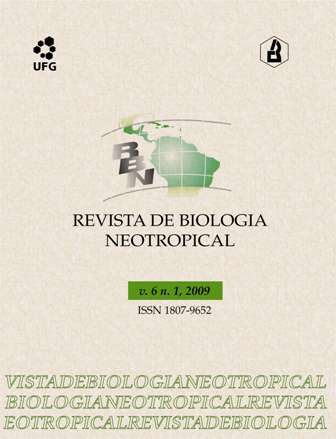Stem morphoanatomy of six species of Phoradendron Nutt. (Viscaceae)
DOI:
https://doi.org/10.5216/rbn.v6i1.12631Keywords:
Plant anatomy, secondary growth, mistletoe, Phoradendron, ViscaceaeAbstract
In this study, we analyzed the morphology and anatomy of stems of six mistletoe species (Phoradendron, Viscaceae) in Maringá, in the state of Paraná. According to the species, the stem may present several shapes in transversal section: circular, losangular with expansions in the extremities or square. The stem is covered with a thin cuticle; epidermic cells form a papilose surface, little or very prominent depending on the species; they present external anticlinal and periclinal very thick and cutinized walls. After secondary growth, this walls and cuticle can break up, forming a cicatrization tissue marea; papilose epidermis may help in the extension growth. Cortical parenchyma is photosynthetic and presents brachysclereids, idioblasts with crystals, phenolic and lipidic substances and also accumulates lipids. Vascular bundles present secondary growth even in the first internodes, originating a compact vascular system with rays containing abundant amyloplasts. The primary phloem and xylem form fibers. The pith initially parenchymatous becomes sclerified with crystals, starch and brachysclereids groups. The shape of the stem in a cross section is the most suitable feature for taxonomic purposes, whereas the anatomical characters complement this.Downloads
References
Ashworth, V. E. T. M. 1997. Transectional anatomy of leaves and young stems of mistletoe genus Phoradendron Nutt. (Viscaceae). Amer. J. Bot. 84: 174.
Ashworth, V. E. T. M. 2000. Phylogenetic relationships in Phoradendreae (Viscaceae) inferred from three regions of the nuclear ribosomal cistron. I. Major lineages and paraphyly of Phoradendron. Syst. Bot. 25: 349-370.
Ashworth, V. E. T. M. & G. Santos. 1997. Wood anatomy of four californian mistletoe species (Phoradendron, Viscaceae). IAWA J. 18: 229-245.
Calvin, C. L. 1967. The vascular tissues and development of sclerenchyma in the stem of the mistletoe, Phoradendron flavences. Bot. Gaz. 128: 35-59.
Cannon, W. A. 1901. The anatomy of Phoradendron villosum Nutt. Bull. Torrey Bot. Club. 28: 374-399.
Carlquist, S. 1985. Wood and stem anatomy of Misodendraceae: systematic and ecological conclusions. Brittonia 37: 58-75.
Der, J. P. & D. L. Nickrent. 2008. A molecular phylogeny of Santalaceae (Santalales). Syst. Bot. 33: 107-116.
Dettke, G. A. & M. A. Milaneze-Gutierre. 2007. Estudo anatômico dos órgãos vegetativos da hemiparasita Phoradendron mucronatum (DC.) Krug & Urb. (Viscaceae). Rev. Bras. Bioc. 5: 534-536.
Ferreira, C. P., H. S. Xavier & R.M.M. Pimentel. 2007. Estudo morfoanatômico foliar de Phoradendron mucronatum (D.C.) Krug. & Urb. Rev. Bras. Bioc. 5: 708-710.
Hauenstein, E, V. Arriagada & M. Latsague. 1990. La epidermis foliar de las Loranthaceae chilenas y su relación con la ecología. Darwiniana 30: 143-153.
Johansen, D. A. 1940. Plant microtechnique. McGraw-Hill, New York.
Kraus, J. E. & M. Arduim. 1997. Manual básico de método em morfologia vegetal. EDUR (Editora Universidade Rural), Rio de Janeiro.
Kuijt, J. 2003. Monograph of Phoradendron (Viscaceae). Syst. Bot. Monogr. 66: 1–643.
Metcalfe, C. R. & L. Chalk. 1979. Loranthaceae. p.1 188-1194. In: C. R. Metcalfe & L. Chalk (Eds.), Anatomy of the Dicotyledons. Oxford, Clarendon Press.
Nickrent, D. L. 1997. The parasitic plant connection. Disponível em: http://www. parasiticplants.siu.edu/.
Rizzini, C. T. 1950. Sobre Phoradendron fragile Urb. Rev. Bras. Biol. 10: 45-58.
Rizzini, C. T. 1968. Lorantáceas catarinenses, p. 1-44. In: R. Reitz (Ed.) Flora ilustrada catarinense. Itajaí, Herbário Barbosa Rodrigues.
Rizzini, C. T. 1978. El género Phoradendron en Venezuela. Rodriguesia 46: 33-125.
Sass, J. E. 1951. Botanical microtechnique. The Iowa State College Press, Ames.
Strasburger, E. 1924. Handbook of practical botany. MacMillan Company, New York.
Varela, B. G. & A. A. Gurni. 1995. Anatomía foliar y caulinar comparativa del muérdago criollo y del muérdago europeo. Acta Farm. Bonaer. 14: 21-29.
Venturelli, M. 1980. Desenvolvimento anatômico do haustório primário de Struthanthus vulgaris Mart. Bol. Bot. USP 8: 47-64.
Venturelli, M. 1981. Estudos sobre Struthanthus vulgaris Mart.: anatomia do fruto e semente e aspectos de germinação, crescimento e desenvolvimento. Rev. Bras. Bot. 4: 131-147.
Venturelli, M. 1984a. Estudos embriológicos em Loranthaceae: Struthanthus flexicaulis Mart. Rev. Bras. Bot. 7: 107-119.
Venturelli, M. 1984b. Estudos sobre Struthanthus vulgaris Mart.: aspectos anatômicos de raiz adventícia, caule e folha. Rev. Bras. Bot. 7: 79-89.
Wilson, C. A. & C. L. Calvin. 2003. Development, taxonomic significance and ecological role of the cuticular epithelium in the Santalales. IAWA J. 24: 129-138.
York, H. H. 1909. The anatomy and some of the biological aspects of the “American mistletoe” (Phoradendron flavescens (Pursh). Nutt. Bull. Univ. Texas 120: 5-31.
Downloads
Published
How to Cite
Issue
Section
License
The expontaneos submmition of the manuscript automaticaly implies in the cession of all patrimonial rights for the Journal of Neotropical Bilogy (RBN) after publication. The autor allow the right of first publication of the article to the RBN, under Creative Commons Attribution 4.0 (CC BY-NC 4.0) Licence.
There are garanties for the authors to the authorial and moral rights, for each one of the articles published by RBN, with permissions:
1. The use of article and contents for the education and researches.
2. The use of the article and their contents, linking to the Article on the web site of the RBN, allowing the divulgation on:
- institutional closed web (intranet).
- open access repositories.
3. Preparation and divulgation of the other publication derived from the article and its content, if there is citation of the original publication by RBN.
4. Make printed copies in small quatinties for personal use.

















